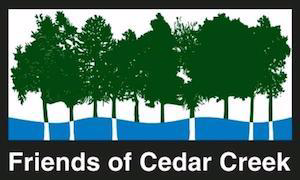Guide to Cedar Creek
Fabulous FernsMary Anna Feitler
Cedar Creek valley’s several native ferns are non-flowering plants which propagate not by seeds but by spores borne in sporangia, dot-like bodies on the back of fronds (leaves). These spores, generally carried by the wind, develop new plants where they fall, though they are not prolific. Ferns also spread by underground stems (others, not in our area, root at the tip of the frond).
Graceful plants, ferns can be tiny or tall, evergreen or not, complex or simple leafed, uncurling as they grow from a small to a fully developed leaf structure. Many thrive in shaded slopes or even barren slopes where they help retard erosion; others thrive in moist shady places such as wooded Cedar Creek banks, marshes, swamps, and bog-margins.
Evergreen ferns in the Cedar Creek area include Christmas Fern, Polystichum acrostichoides, which grows to about 36” with eared leaflets nearly opposite on a brown scaly stalk, and a brown scaly crown. Ebony Spleenwort, Asplenium platyneuron, is shorter, growing to about 15”, with black stems and simple leaflets with ears (particularly the fertile leaflets).
Cinnamon fern, Osmunda cinnamomea, is handsome and large, growing to 36”. Its dark green sterile fronds are narrowly lance shaped and nearly opposite in placement on the stalk. Fertile fronds first appear green, at maturity turning cinnamon brown with wooly cinnamon-colored tufts at the base.
The sensitive fern, Onoclea sensibilis, is a coarse large leaf fern of up to 24”. The light green leaves are somewhat triangular with connected leaflets (a webbed look) at the leaf axis. Because the plant is sensitive to frost, it dies back easily. Fertile leaves are shorter, 12” or so, with tightly packed branchlets that appear to be covered with beads.
Lady fern, Anthyrium Filix-femina, has a classic fern shape. It grows to approximately 30” with arching, lacy, light-green leaves in a rounded cluster at the base. The leaflets are cut and recut on a smooth (not wooly) leaf axis, and the spore-bearing dots on the backs are short and curved.
Cut-leaf grape fern, Botrichium dissectum, is somewhat variable in appearance yet easily identified by its characteristic single, three-part sterile leaf with a single fertile frond (sporophyll) from the base--the whole less than 12”. The semi-evergreen sterile leaf tends to turn bronze-brown in the fall.
More to Explore . . .
- Wildflowers and Ferns of Indiana Forests: A Field Guide (Indiana Natural Science). Michael A. Homoya. Indiana University Press. 2011.
Ferns Image Information
-
Digital PR
Christmas Fern: fiddleheads
(Carol Roberts)
-
Events
Lady Fern
(Heather Baker)







